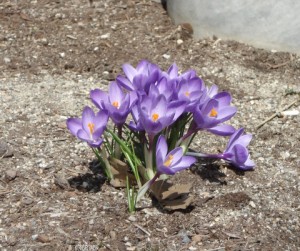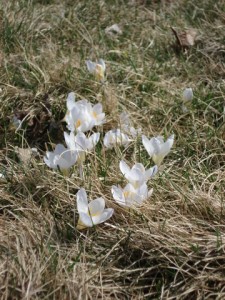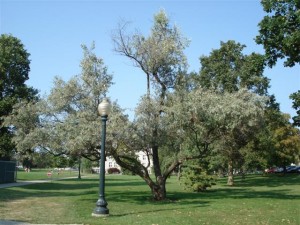I’ve posted a new export of the campus tree map Google Earth file, on the Campus Tree map page. I’ve added quite a few more campus trees to it, and the official count now stands at 2279. There are a couple of more locations I would like to map, and quite a few more pictures I’d like to find the time to take. This iteration, though, is pretty close to complete.
I risked the potato chips in the keyboard, brushed off my math skills, and starting looking at our tree population in Excel over lunch(es). I’m no spreadsheet guru, but the information I pulled out is interesting, and tells me we’re pointed in the right direction in our urban forest here.
I’m sure I’ve written about this before…An urban forest population such as ours should have no more than 30% of the population from one family, 20% from one genus, and 10% from one species. Some sources say 15-10-5%, but that’s hard this far north. (Brief refresher- Roseaceae is an example of a family, and includes many types of plants, from roses, to crabapples, to Shadblow, etc. A genus is one type of tree, like Maple. A species is a specific type of tree, like Sugar Maple.) The reasons for a diverse population make sense-let’s look at an example. Emerald Ash Borer (pdf) is on it’s way to Vermont, as quickly as a couple of years. Most recently is has been found 30 miles north of the border in Carigan, Quebec. It attacks the Ash genus, consisting of both Green and White Ash here on campus, and they make up 8.7% of our population, and 8.3% of our canopy cover. Losing our Ash on campus would make a big dent in our population, but imagine if Ash made up greater than 20% of the population, as it has in some urban street tree populations elsewhere.
Our potential problems lie in the Aceraceae family, or maples. We’re ok on the family level, with 22.7% of our trees in the Maple family. The maple family only consists of one genus, Acer, making the genus population a worrisome 22.7% as well. Sugar Maple as a species makes up 12.3% of our trees, and 15.2% of our tree canopy cover (shade), so that is a possible weak link in our forest, should some insect or disease come along to target specifically Sugar maples.
Other statistics aren’t cause for alarm, but are worth noting. The Pinaceae family, Spruce, Pine, and Fir, make up 22.6% of the population, White Pine alone clocking in at 6.6%. Crabapples are 9.3%, close to the 10% species limit. Slightly more than half, (54.2%) of our tree canopy cover on campus is made up of only 10 species of trees-Norway, Red an d Sugar Maples, Paper Birch, White and Green Ash, Crabapples, Norway Spruce, and White and Austrian Pine.
Another set of data gleaned is the age of the forest. I’m an advocate of planting trees every year, to keep a mixed age population. I measure this not from true age (can’t really know that without cutting trees down), but simply by looking at trunk size, a measurement called Diameter at Breast Height. Young trees, less than 6″ in diameter, are 31% of the population, 6-12″ teenagers are 33%, 12-18″ trees make up 21%, 18-24″ at only 7.6%, and the grand trees larger than 24″ are 7.5% of our population. (There are 34 36″ + trees on campus, 1.5% of the population. I’m thinking of naming them individually) This seems to be a good mixed age population-we wouldn’t want all the trees reaching old age at the same time.
So in all, a good mixed age population, and fairly good species diveristy. Im still open to planting Sugar Maples even, though I’ve been leaning towards oaks in the last couple of years. And I’m always looking for trees we don’t have. This year’s new tree species is Amur Maackia, I’ve already got one tagged for us at a local nursery. I’m open to locations…





You must be logged in to post a comment.